Photographs by Hiroaki Shinohara.
Who is Utagawa Hiroshige?
Utagawa Hiroshige, the master of landscape portrayal, depicted sites throughout Japan in his ukiyo-e woodblock prints. Along with his portrayal of famous scenic spots, Hiroshige, who was born in Edo (former name of Tokyo), was also fond of capturing scenes from the daily lives of people in the shitamachi, the old downtown area of Edo. These included people going to worship at Yushima Tenman-gu Shrine while men enjoyed drinks at the rest house next to the shrine’s torii gate; cherry blossoms in full bloom in Ueno Park and Dangozaka in Sendagi; and Dokanyama, popular among the general public as a site to relax and listen to insects chirp.
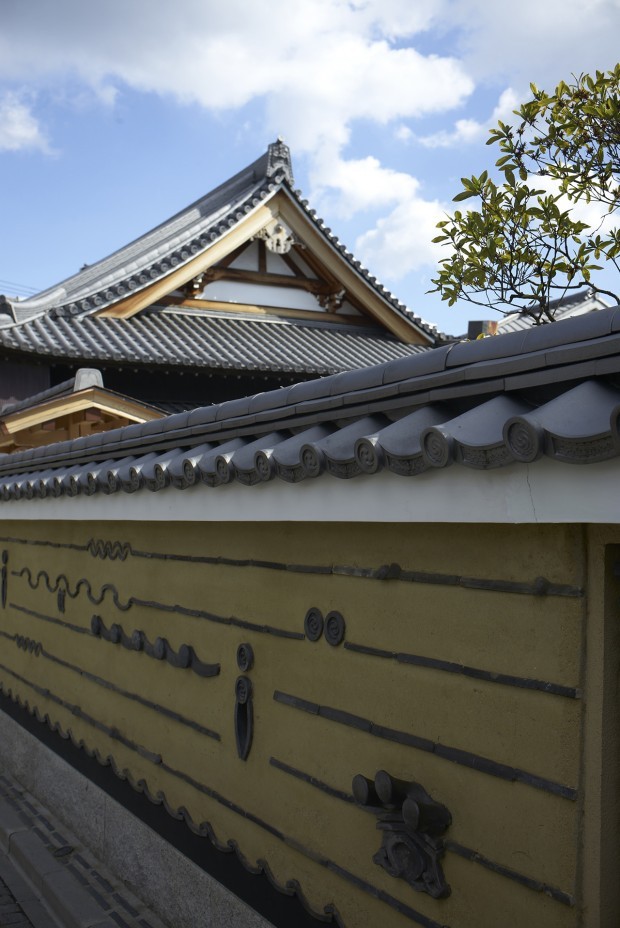 The roofed earthen wall of Kannon-ji Temple in the Yanesen area.
The roofed earthen wall of Kannon-ji Temple in the Yanesen area.
Now let’s follow Hiroshige’s footsteps by taking a stroll from Ueno Park to Yanaka, Nezu, and Sendagi, collectively known as the Yanesen area.
From Ueno to Nezu
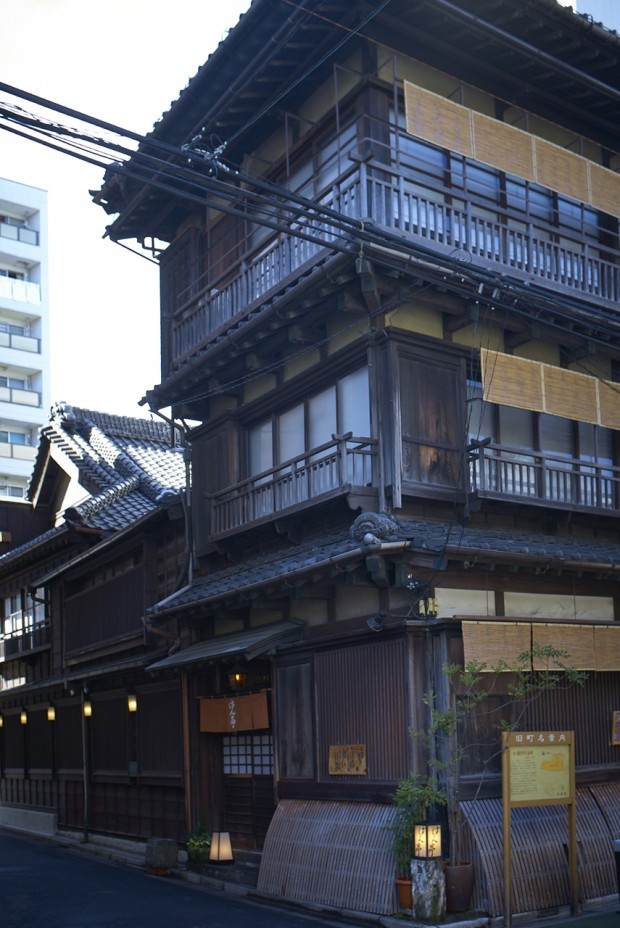 Hantei occupies a wooden three-story building, a rare sight in Tokyo now.
Hantei occupies a wooden three-story building, a rare sight in Tokyo now.
Starting from Kiyomizu Kannon-do Temple, walk by Benten-do Temple and Shinobazu Pond, and head in the direction of Nezu. A classical, wooden three-story building is sure to catch your eye on Shinobazu-dori Avenue. This is Hantei, a famous kushiage restaurant. Though located on a street bustling with cars, time seems to have stopped here at this renovated Meiji era building. As there are few such buildings remaining in Tokyo, it’s quite a heartwarming sight to behold.
If you have room in your stomach, you must try Hantei’s kushiage—skewered tidbits lightly battered, deep-fried, and delightfully crispy. We recommend dining at the low tables in the Japanese rooms on the second and third floors.
See Nezu Shrine’s azaleas in all their glory!
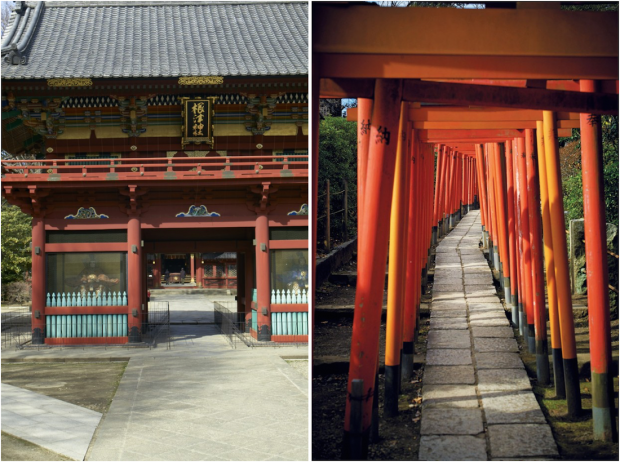 Nezu Shrine, often depicted in ukiyo-e. The row of vermilion torii shrine gates of Otome Inari Shrine, located on the grounds of Nezu Shrine, is a popular photo spot. 1-28-9 Nezu, Bunkyo-ku, Tokyo, Official website
Nezu Shrine, often depicted in ukiyo-e. The row of vermilion torii shrine gates of Otome Inari Shrine, located on the grounds of Nezu Shrine, is a popular photo spot. 1-28-9 Nezu, Bunkyo-ku, Tokyo, Official website
Next is Nezu Shrine. Also called Nezu no Gongensama, this shrine has been depicted in many ways in ukiyo-e. The main building of the shrine was consecrated by fifth shogun Tokugawa Tsunayoshi in 1706. The Karamon main gate, Romon gate and several other structures have been preserved intact since that time and are, of course, nationally designated Important Cultural Properties.
Just as Ueno is known for its cherry blossoms, Nezu Shrine is famous for its azaleas. In the azalea garden, which decorates a slope in the shrine grounds in various shades of pink, 3,000 early- and late-blooming azalea shrubs flower over a course of one month, from sometime in April on into May. After praying at the shrine, let’s move on to Dangozaka. This is the spot Hiroshige depicted in the “One Hundred Famous Views of Edo: The Flower Pavilion on Dango Slope, Sendagi,” which showed the cherry blossoms in full bloom and the rest house, Shisentei, at the top of a slope, Dangozaka. Neither Shisentei nor the rows of cherry trees remain, but the slope is still called Dangozaka in memory of days gone by.
You can even find today’s “kawaii” culture in Yanesen
Now, while imaging the hustle and bustle of the neighborhood during Hiroshige’s Edo period, let’s head toward Sansakizaka. Hunt for gifts to take home at Kikumi Senbei, a rice cracker shop, and Isetatsu, a shop offering Edo chiyogami paper, while walking up the slope to arrive at the temple town, Yanaka.
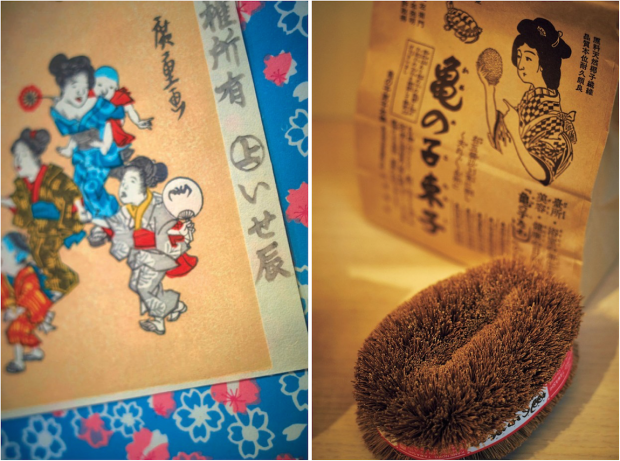 Isetatsu’s chiyogami paper drawn by Hiroshige, and Kamenoko Tawashi’s Yanaka Store, the world’s first shop dedicated to scrubbing brushes.
Isetatsu’s chiyogami paper drawn by Hiroshige, and Kamenoko Tawashi’s Yanaka Store, the world’s first shop dedicated to scrubbing brushes.
Many temples were gathered in this neighborhood as a result of Edo’s city planning, and many are still found today scattered throughout the area. Traces of old Edo remain in structures such as the roofed earthen wall of Kannon-ji Temple which is pictured at the top of this article.
During the Edo period, Yanaka was also a cultural trendsetter, and so it’s just like this area to have unique establishments putting down roots here, including the warm and calming Sansakizaka Café; the world’s first scrubbing brush store, Kamenoko Tawashi; the Asakura Museum of Sculpture, which used to be the home and atelier of sculptor Fumio Asakura; and a gallery selling serving dishes and other vessels, Idaden. The neighborhood is full of new discoveries that can be made each time you visit.
Sunsets and cats go well together
We’re nearly at the end of our Yanesen walk. At the bottom of the steps of “Yuyake Dandan,” a well-known site for watching sunsets, is Yanaka Ginza. But before we start strolling through this shopping street, let’s stop by Himitsudo to try its popular, fluffy shaved ice. “Who would ever want to line up for shaved ice?” Don’t make the mistake of not taking this place seriously! Himitsudo offers shaved ice that will have you begging to line up to eat. And it tastes like…well, you’ll just have to try it yourself!
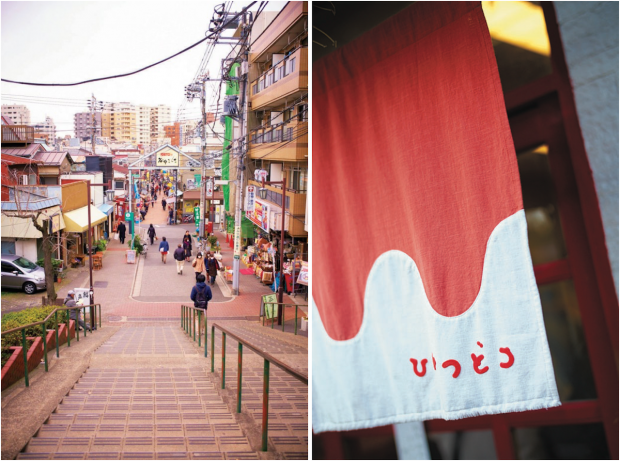 Yuyake Dandan and an eatery serving shaved ice, Himitsudo.
Yuyake Dandan and an eatery serving shaved ice, Himitsudo.
Get energy from the lively shopping street
The Yanaka Ginza shopping street is full of energy—international tourists buying and eating croquettes, kuzumochi, yakitori, and many other goodies, and homemakers rushing on bicycles to buy food for dinner.
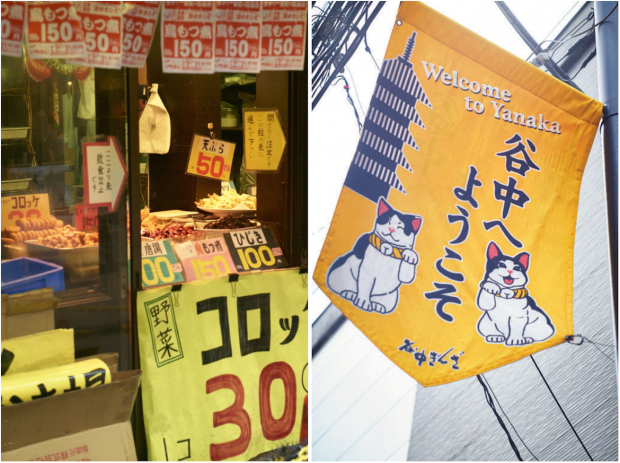 Yanaka Ginza bustles with tourists on weekends.
Yanaka Ginza bustles with tourists on weekends.
The final place we wish to introduce is the site Hiroshige depicted in “Famous Places of the Eastern Capital: Listening to Insects at Dokan Hill.” Dokan Hill, or Dokanyama, is a hill that overlooks what is currently the train platform of JR Nishi-Nippori Station. “Listening to insects” is the stylish custom of enjoying a respite from the summer’s heat by listening to insects sing. In this ukiyo-e, men drink sake on a hill, while women carrying uchiwa fans and a child walk below, and a large moon shows its face in the far background, for a tasteful one scene from summer in the Edo period. Although it looks nothing like this today, just standing in places depicted by Hiroshige will make you feel like you can warp back 300 years.
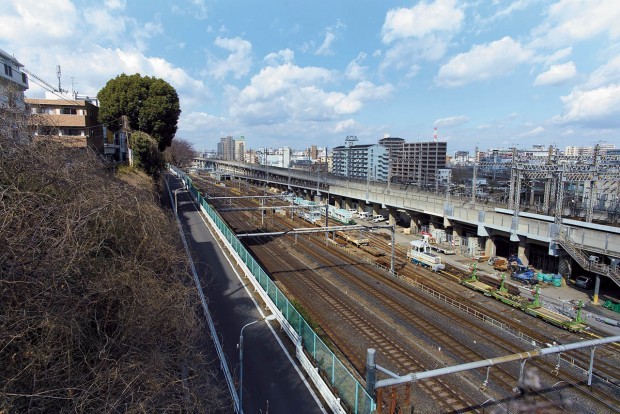 The site depicted by Hiroshige in his “Famous Places of the Eastern Capital: Listening to Insects at Dokan Hill” overlooks what is currently JR Nishi-Nippori Station.
The site depicted by Hiroshige in his “Famous Places of the Eastern Capital: Listening to Insects at Dokan Hill” overlooks what is currently JR Nishi-Nippori Station.
Places to stop by in Yanesen
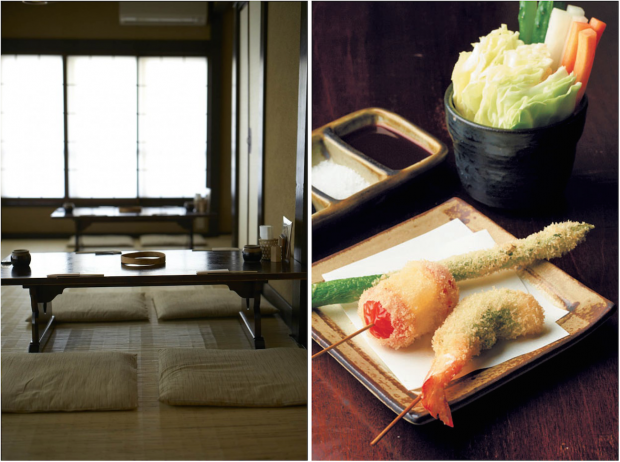
Hantei: Dining in Meiji-era retro style
A kushiage restaurant that’s a fixture of a walk around Yanesen, Hantei is popular for its skewers of seasonal ingredients, dipped in batter and deep-fried. The three-story wooden building was built in the Meiji era, and has been designated a tangible cultural asset. A set of six kushiage with an appetizer and raw vegetables is offered from 2,835 yen.
2-12-15 Nezu, Bunkyo-ku, Tokyo, 11:30 – 14:00 (last order) and 17:00 – 22:00 (last order), Closed on Mondays (open if Monday is a holiday, and closed the following day)
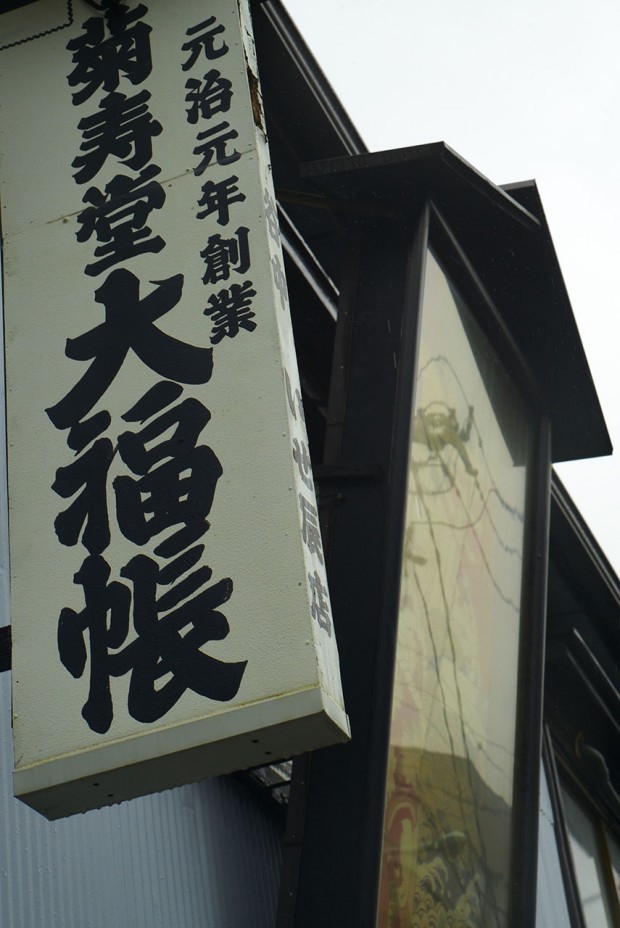
Kikujudo Isetatsu Yanaka Main Store: “Edo kawaii” as a gift to take home
This store was founded at the end of the Edo period and deals exclusively in Edo chiyogami paper. The store is overflowing with colorful hand-printed chiyogami that reflect the Edo culture, take themes from Kabuki theater, and other motifs. The ukiyo-e in the photo above was drawn by Hiroshige. Isetatsu also has a Sendagi store near Dangozaka.
2-18-9 Yanaka, Taito-ku, Tokyo, 10:00 – 18:00, Open every day except New Year’s Day
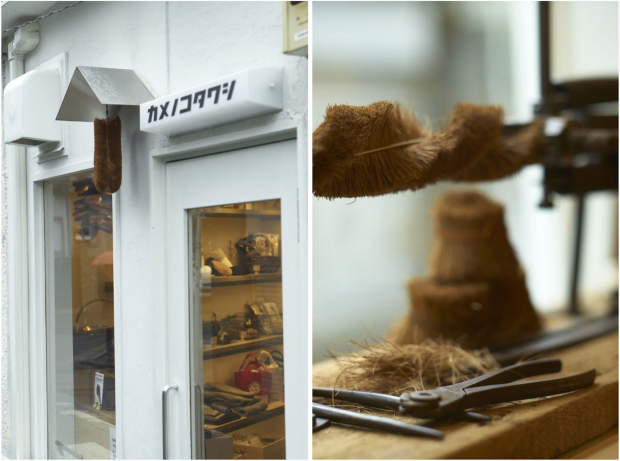
Kamenoko Tawashi Yanaka Store: So many cute scrubbing brushes!
Kamenoko Tawashi’s shop is located on a small road leading from Nezu to Sendagi. The white-toned stylish shop has an atmosphere of a variety store or bakery. In addition to its line of well-known kitchen scrubbing brushes, original products such as body brushes are also displayed in the store.
2-5-14 Yanaka, Taito-ku, Tokyo, 11:00 – 18:00, Closed on Mondays (open if Monday is a holiday, and closed the following day)
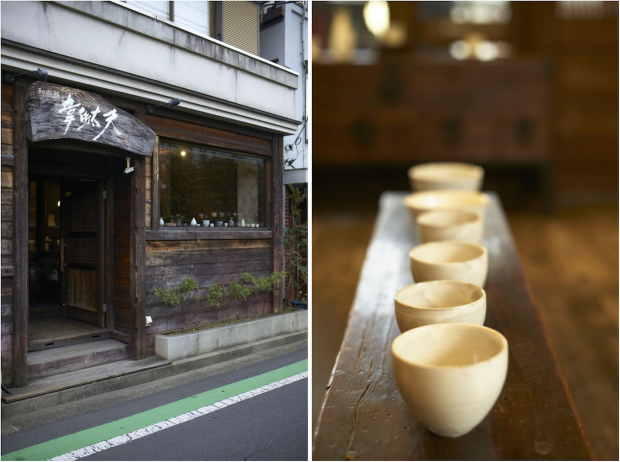
Idaden: Full of good taste!
Displayed in this cozy store are serving dishes and other vessels made by domestic and foreign artists, which have been tastefully selected by the proprietress. The handpicked assortment ranges from handy, everyday use dishes to large platters that will brighten up the dining table. Artist exhibits are held regularly in the gallery in the basement.
5-2-24 Yanaka, Taito-ku, Tokyo, 11:00 – 18:00, Closed on Mondays and Tuesdays
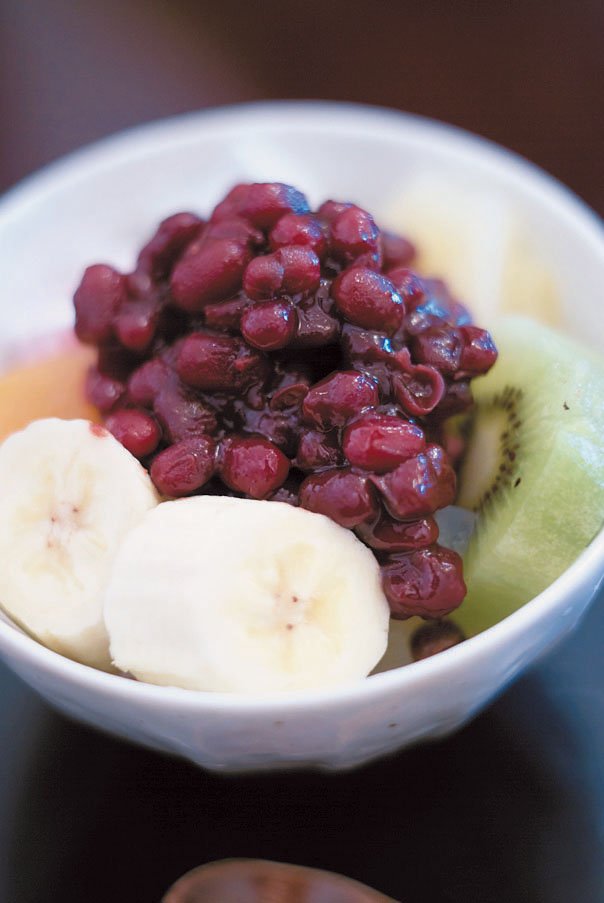
Sansakizaka Café: A refreshing sweet
Try anmitsu, a dessert made from jelly, fruit, and sweet adzuki bean paste, at the Sansakizaka Café found along the slope.
5-4-14 Yanaka, Taito-ku, Tokyo
Let’s explore!
Explore the Yanesen area and the goods you can discover there with these videos!












